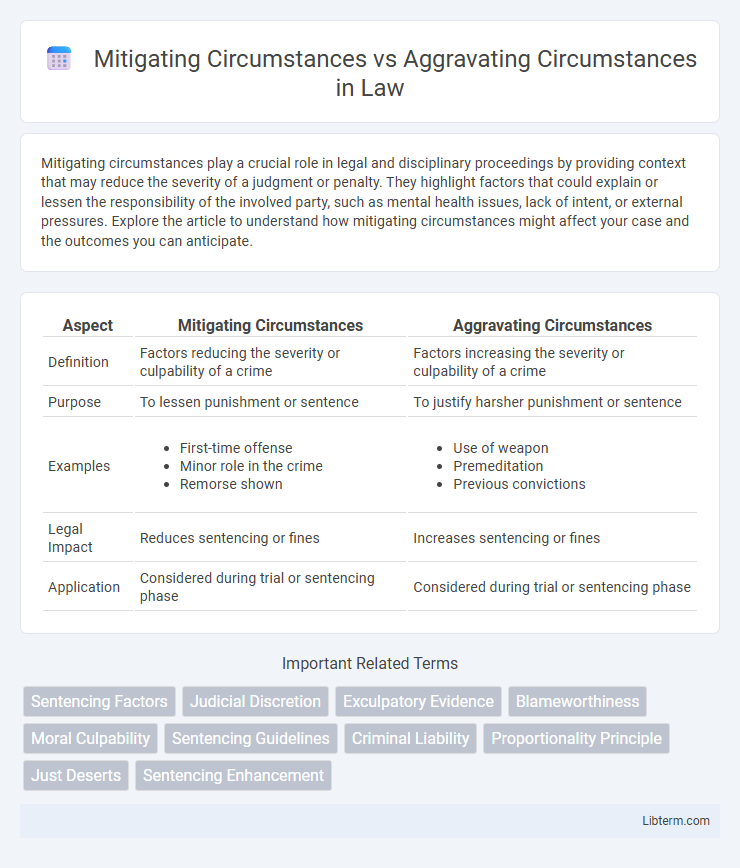Mitigating circumstances play a crucial role in legal and disciplinary proceedings by providing context that may reduce the severity of a judgment or penalty. They highlight factors that could explain or lessen the responsibility of the involved party, such as mental health issues, lack of intent, or external pressures. Explore the article to understand how mitigating circumstances might affect your case and the outcomes you can anticipate.
Table of Comparison
| Aspect | Mitigating Circumstances | Aggravating Circumstances |
|---|---|---|
| Definition | Factors reducing the severity or culpability of a crime | Factors increasing the severity or culpability of a crime |
| Purpose | To lessen punishment or sentence | To justify harsher punishment or sentence |
| Examples |
|
|
| Legal Impact | Reduces sentencing or fines | Increases sentencing or fines |
| Application | Considered during trial or sentencing phase | Considered during trial or sentencing phase |
Introduction to Mitigating and Aggravating Circumstances
Mitigating circumstances refer to factors that reduce the severity or culpability of a defendant's actions, often leading to a lesser sentence or penalty. Aggravating circumstances, on the other hand, are elements that increase the seriousness or culpability of the offense, potentially resulting in harsher punishment. Understanding the distinction between these circumstances is crucial in legal proceedings for fair sentencing and justice administration.
Definition of Mitigating Circumstances
Mitigating circumstances refer to factors or conditions that reduce the severity or culpability of a defendant's actions, potentially leading to a lighter sentence or lesser charge. These circumstances may include lack of intent, mental illness, duress, or provocation, which demonstrate diminished responsibility. Legal systems consider mitigating circumstances to ensure fair judgment by accounting for context that lessens moral blame.
Definition of Aggravating Circumstances
Aggravating circumstances refer to specific factors or conditions that increase the severity or culpability of a criminal act, leading to harsher penalties or sentencing. These include elements such as premeditation, the use of a deadly weapon, prior criminal history, or committing the offense in a particularly cruel or heinous manner. Legal systems emphasize aggravating circumstances to ensure that punishments appropriately reflect the gravity of the offense and the offender's intent or behavior.
Key Differences Between Mitigating and Aggravating Circumstances
Mitigating circumstances reduce the severity or culpability of a criminal act by providing context such as lack of intent, mental illness, or provocation, which may lead to lighter sentences. Aggravating circumstances increase the severity or culpability through factors like use of a weapon, prior convictions, or committing the offense in a vulnerable location, resulting in harsher penalties. The key difference lies in the impact on sentencing, where mitigating circumstances justify leniency and aggravating circumstances justify increased punishment.
Legal Relevance in Criminal Sentencing
Mitigating circumstances in criminal sentencing reduce the severity of punishment by highlighting factors such as lack of intent, mental illness, or duress, which lessen the defendant's moral culpability. Aggravating circumstances increase the gravity of the offense, justifying harsher penalties due to elements like prior convictions, use of a weapon, or cruelty during the crime. Courts assess these elements to balance justice and ensure sentencing reflects both the nature of the crime and the defendant's personal context.
Common Examples of Mitigating Circumstances
Common examples of mitigating circumstances include mental illness, lack of prior criminal record, and acting under duress or coercion. These factors can reduce the severity of charges or penalties by demonstrating reduced culpability. Courts often consider youth, genuine remorse, and cooperation with law enforcement as additional mitigating elements.
Common Examples of Aggravating Circumstances
Common examples of aggravating circumstances include prior criminal history, use of a weapon during the commission of a crime, and the presence of vulnerable victims such as children or the elderly. Other aggravating factors often involve the crime being motivated by hate, displaying extreme cruelty or premeditation, and committing offenses in positions of trust or authority. These elements typically lead to harsher penalties as they reflect increased culpability or societal harm.
How Courts Weigh Mitigating vs. Aggravating Factors
Courts weigh mitigating circumstances by evaluating factors that reduce the defendant's culpability, such as lack of prior offenses, mental health issues, or genuine remorse, while aggravating circumstances include elements like premeditation, cruelty, or prior convictions that increase culpability. The balance between these factors influences sentencing severity, with judges applying legal standards and precedent to ensure proportional justice. Detailed case law and statutory guidelines provide frameworks for courts to systematically assess how mitigating and aggravating factors impact final judgments.
Impact on Case Outcomes and Sentencing Decisions
Mitigating circumstances such as lack of prior criminal history or genuine remorse can reduce the severity of sentencing by providing context that diminishes the defendant's culpability. Aggravating circumstances like use of a weapon, premeditation, or prior convictions typically lead to harsher sentences due to increased perceived danger or culpability. Courts weigh these factors carefully, directly influencing case outcomes by balancing the defendant's intent and the offense's impact on victims and society.
Conclusion: Importance in the Justice System
Mitigating circumstances reduce a defendant's culpability, leading to lighter sentences, while aggravating circumstances increase responsibility and can result in harsher penalties. Both factors are essential in delivering fair and balanced judicial outcomes by considering the full context of a case. Incorporating these elements ensures that justice is tailored to individual circumstances, promoting equity and proportionality in sentencing.
Mitigating Circumstances Infographic

 libterm.com
libterm.com